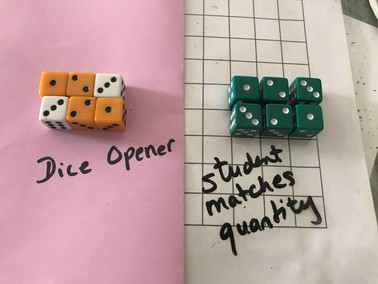Dimensional Thinking is Fundamental UPDATE 2024
- glorway
- Aug 14, 2021
- 3 min read
Updated: Apr 11, 2024
Jamie found these 10 by 10 laminated grids already in her Grade 1 classroom and asked what ideas I had for them. Across all grades, including Kindergarten I would use them to develop 2 dimensional thinking. Seeing and thinking horizontally and vertically. Can you find a specific square by zeroing in from the top and bottom. (remember battleship?) Grids build a fundamental form of reasoning that is required if we want to shift students from counting by ones to thinking in collections, groups or units (multiplication, place value, fractions & decimals).
Here are a few of my connections.

Use the dice opener slides. Start with just a section of the array and show students an arrangement of dice or dots or bingo chips or blocks. They make the same arrangement on their grid. The focus is matching the arrangement.
I encourage explaining using horizontal, vertical, between, beside.
As another variation, students can translate arrangements to numbers.
The initial tasks above focus on matching quantities, translating quantities to symbols or other materials and developing the ability to organize arrays in rows and columns.
Use the dice openers and the Dice Cards posted in the Summer Classroom. Begin with rows of 3 by 2, 2 by 3 then challenge students to work with larger arrays.
As Grade 1s build their skill with trusting small quantities, look for number combinations and equalities in the translated number grids. Grade 2s and 3s can certainly be looking for ways to find totals.
Spatially we want students of all ages to have lots of experience with negotiating grid paper to prepare them to understand area, perimeter and multiplicative growth which occurs in 2 or 3 directions. Area models are FOUNDATIONAL to multiplicative thinking and proportional reasoning. WE CANNOT LEAVE OUR STUDENTS IN ADDITION.
As a READINESS for multiplication in the primary grades, the curriculum includes seeing and thinking in equal groups. This is preparation for multiplying. I can think 9 is 4 and 5 or 6 and 3 but it is also 3 threes or 3(3). TO DISTINGUISH THIS THINKING FROM just addition, Thinking 101 materials encourage using parentheses and connecting to words right from the start.
You do not have to agree with me, BUT you need to know that I discourage writing
9 = 3 + 3 + 3 and suggesting that it is a step to multiplying. It is not. Instead make them feel smart and confident by showing them the difference between thinking in parts and thinking in equal parts. That's the key to multiplication and the doorway to success with place value, fractions and decimals. Kinders love learning to use parentheses.
On these grids, TEACH students to outline a row or column and then build it out into a rectangle.
Outline a horizontal 3. It will be a thin rectangle. Now use it as your master unit and "grow" the rectangle by 3s.

And here are a couple other quick ideas that occurred to me. I have emphasized the importance of tracing, outlining, using a ruler or straight edge to create "straight" lines and to connect dots. These ready made grids could be used for the activities below. Finding things that fit on the grid and tracing the rectangle (or square) it fills. Outlining shapes and counting their sides. Making and matching puzzles made of coloured squares. These are any grade tasks that build spatial reasoning skills.
Teaching students at all LEVELS how to use grids to organize, read, interpret, and COMPARE is a MUST. Working on grids this way develops "Dimensional Thinking". Thinking in 2 dimensions, growth in two directions is a critical understanding that builds MULTIPLICATIVE & PROPORTIONAL reasoning. Multiplicative, not additive, reasoning is THE KEY TO RECALL WITH BASIC FACTS for multiplication and division.






































Comments